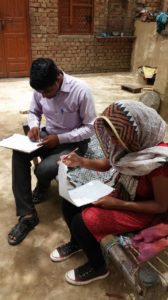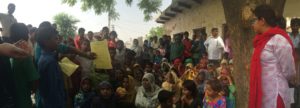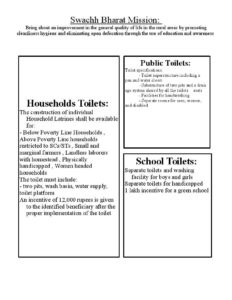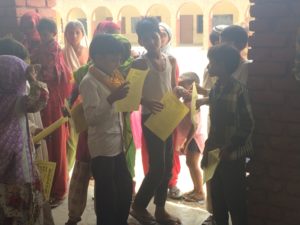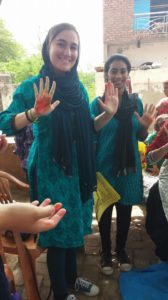Questionnaires/ surveys
We created a baseline questionnaire to analyse the current situation of the communities where the Swachh Bharat mission is being promoted by our project. The survey has questions that range from the awareness government schemes in place for rural development to the understanding of a link between health and sanitation practices.
(Field Staff Birsingh and Prerana Krishnan conducting baseline questionnaire surveys)
These surveys will be answered by the Village Health Sanitation and Nutrition Center (VHSNC) members as well as the Panchayat (Village level council) which in this case, is the same for both villages, as well as community members that are not part of any village institution. This is for the purpose of comparing the different levels of awareness between the individuals trained by Sehgal foundation and the government compared to the regular community members.
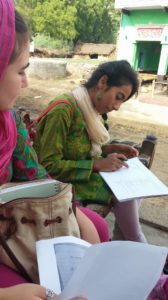
(Rachel Feldman and Prerana Krishnan conducting baseline questionnaire surveys)
In order to chose the sample population that would answer the surveys, we used cluster sampling as well as convenience sampling . Cluster sampling helped us divide the VHNSC and Panchayat (local government) members from the general population, however from both of these clusters the respondents were chosen by convenience sampling. Whoever was in the area at the time we were conducting the survey was selected until we reached 15 surveys completed in Mundheta and 5 surveys completed in Naseerpuri in an attempt to make our sample representative.
Workshops
We have created a list of individuals who do not have a toilet in their home from the villages of Mundheta and Naseerpuri from the micro-planning previously done, where we mapped the two villages and conducted a brief survey asking whether the household had a toilet or not. This list gave us the number of individuals who do not have toilets in order to get them to attend a workshop where we will promote the Swachh Bharat Mission as well as the implementation of toilets.
(Workshop at Naseerpuri village, passing out a flier that details the proper steps on washing hands)
We met with community members to present our findings from the data collected through the questionnaires we conducted during our micro-planning. The findings we presented during the workshops including the number of households with a toilet compared to the number of them without, the amount of functional toilets in the village and the common problems facing the construction and upkeep of toilets. We believe that with this knowledge, the villagers can better assess the need of the community and better express these needs to the panchayat to better focus the renovations of the village.
We created and used IEC materials that promoted the use of sanitary practices and the benefits of toilets to hand out during the workshops to provide a resource they can refer back to whenever necessary. These material consisted of handbills which we had both prepared ourselves and used from last year’s group, as they proved to be successful in last year’s villages. We used three different handbills. The first explains the Swachh Bharat mission, its elements, and its importance in its different different spheres (school toilets, household toilets, and public toilets). The second details the steps of hand-washing and its importance in preventing the spread of germs and disease as well as the proper times . The third explains the benefits of building a toilet.
(Young boy reading the flier that details the proper steps for hand-washing)
We held a workshop with the topic of sanitation, it consisted of an interactive game using paint to represent and bringawareness to the rapid spread of germs. The interns first demonstrated the activity by dabbing paint and shaking each others hands creating a mixture of colors on each of our hands; this mixture of colors represented the rapid spread of germs with one simple handshake. It was followed by a demonstrations of the proper steps for hand-washing by the interns were the paint was washed off during 30 seconds, making sure to reach between fingers, under nails and around wrists with soap.
(Young girl washing her hands after the demonstration of proper hand-washing by Interns)
The activity became open to child volunteers who wanted to demonstrate for the group how to properly wash their hands. The interns were able to correct the process if any mistakes were made or if any steps were missed. The demonstration highlighted the benefits that hand washing has on health.
-Stephanie Muench

